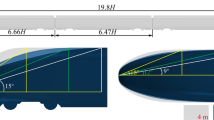Abstract
A high-speed train enters the tunnel and loud noise occurs at the tunnel exit. This is due to compression wave generated by a train entering into the tunnel. It is important for developing further speed train to clarify the mechanism of the compression wave propagation, which has been strongly affected by the boundary layer characteristics. The purpose of the present study is to clarify the turbulent transition characteristics of unsteady boundary layer, which is generated by sudden started flow induced by weak-compression wave (amount of pressure change: Δp ≈ 2 kPa). The boundary layer is transited by tripping wires, and the velocity distributions are measured by a hot wire anemometer. The results show that the boundary layer transition is confirmed by spectrum analysis of the velocity fluctuation. The transition process of the boundary layer is observed by changing the position of tripping wires, and the turbulent boundary layer is maintained down to about 310 of Reynolds number based on the momentum thickness in the case of inputting the large disturbance into the boundary layer.
Access this chapter
Tax calculation will be finalised at checkout
Purchases are for personal use only
Similar content being viewed by others
References
T. Miyachi, A Theoretical and Experimental Study on Tunnel Micro-Pressure Wave, Doctor Thesis of Osaka Prefecture University (in Japanese), 2012
K. Takashima, K. Nozaki, S. Sakaue, T. Arai, T. Miyachi, Hot Wire Measurements on Flow Induced by Propagating Weak Compression Wave, Annual Meeting of The Japan Society of Fluid Mechanics, Miyagi, Japan, 15–17 Sept (in Japanese), 2014
D. Tanikawa, K. Takashima, S. Sakaue, T. Arai, T. Miyachi, Turbulent Enhancement of Boundary Layer Induced by Weak-Pressure Wave, Annual Meeting of The Japan Society of Fluid Mechanics, Tokyo, Japan, 26–28 Sept (in Japanese), 2015
S. Pirozzoli, F. Grasso, T.B. Gatski, Direct numerical simulation and analysis of a spatially evolving supersonic turbulent boundary layer at M = 2.25. Phys. Fluids 16(3), 530–545 (2004)
C. Nakaya, T. Kambe, Stability of Rayleigh flow. J. Phys. Soc. Jpn. 22(1), 306–309 (1967)
Author information
Authors and Affiliations
Corresponding author
Editor information
Editors and Affiliations
Rights and permissions
Copyright information
© 2019 Springer International Publishing AG, part of Springer Nature
About this paper
Cite this paper
Tanikawa, D., Hashimoto, T., Sakaue, S., Arai, T., Miyachi, T. (2019). A Study on Turbulent Transition of Unsteady Boundary Layer Induced by Weak-Compression Wave. In: Sasoh, A., Aoki, T., Katayama, M. (eds) 31st International Symposium on Shock Waves 1. ISSW 2017. Springer, Cham. https://doi.org/10.1007/978-3-319-91020-8_130
Download citation
DOI: https://doi.org/10.1007/978-3-319-91020-8_130
Published:
Publisher Name: Springer, Cham
Print ISBN: 978-3-319-91019-2
Online ISBN: 978-3-319-91020-8
eBook Packages: EngineeringEngineering (R0)



